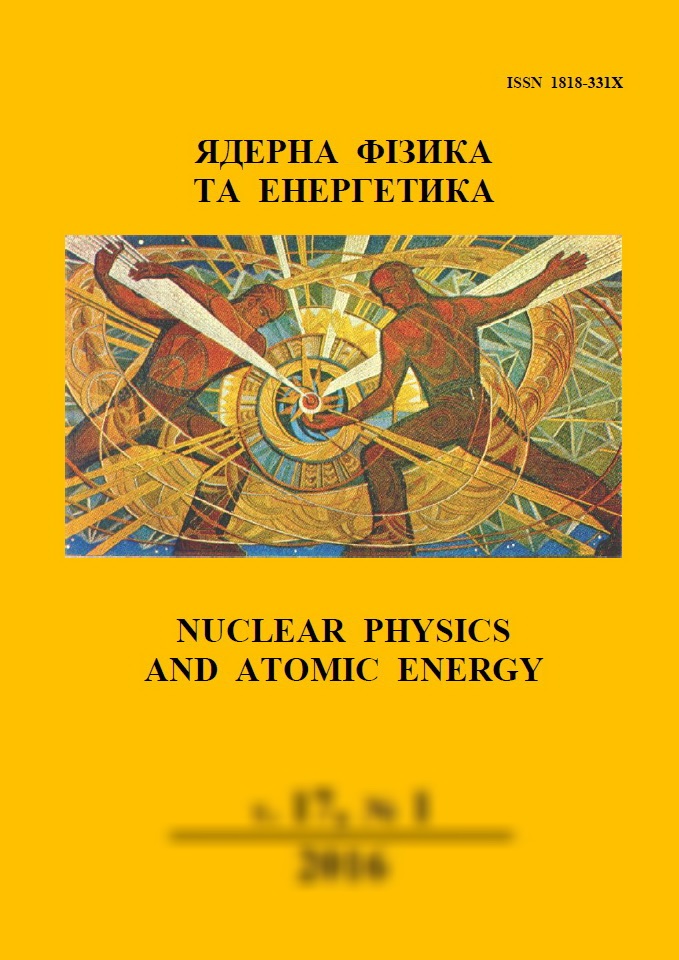 |
ядерна ф≥зика та енергетика
Nuclear Physics and Atomic Energy
ISSN:
1818-331X (Print), 2074-0565 (Online)
Publisher:
Institute for Nuclear Research of the National Academy of Sciences of Ukraine
Languages:
Ukrainian, English
Periodicity:
4 times per year
Open access peer reviewed journal
|
Nucl. Phys. At. Energy 2012, volume 13, issue 2, pages 193-202.
Section: Engineering and Methods of Experiment.
Received: 25.11.2011; Published online: 30.06.2012.
 Full text (en)
Full text (en)
https://doi.org/10.15407/jnpae2012.02.193
Gamma activity as a guide for the building raw materials selection and controlling the environmental hazards
T. Ibrahim1, Kh. H. Ali1, A. Sroor2, N. Walley El-Dine2, A. El-Shershaby2, Z. El-Tayeb2
1Geological Studies Department, Nuclear Materials Authority, Cairo, Egypt
2Nuclear Physics Laboratory, Faculty of Girls, Ain Shams University, Cairo, Egypt
Abstract:
The spectrometric measurements can provide an alarm for the radiation activity and radioelement concentrations.
The activity increase over the ambient background can be achieved by well calibrated gamma-spectrometers. In comparison between Wadi El-Dahl and Abu Zawal quarries for building raw materials (feldspar), the activity concentration
of El-Dahl stream sediments are 54.5 and 44.5 Bq/kg for uranium and thorium respectively. While the activity concentration of Abu Zawal rock quarry are 167.03 and 79.77 Bq/kg for uranium and thorium respectively. These activities
yielding effective dose rates of 0.63 mSv/y for Wadi El-Dahl stream sediments and 1.48 mSv/y for Abu Zawal rock
quarry. In summary, the spectrometric measurements are excellent selective tool to monitoring the environment against
the radiation risk. In this aspect, Wadi El-Dahl stream sediment quarry is considered as the more suitable for producing
feldspar as a raw materials to building industry. In comparison, Abu Zawal rock quarry has a higher effective dose rate
that exceeds the international permissible limits which is 1 mSv/y. A total of 19 feldspar samples were completely described
regarding their general chemical features by using x-ray fluorescence. From the study all the samples contain high concentration of barium and rubidium which can be separated using different methods in order to use in different important
industry.
Keywords:
ground spectrometric survey, x-ray fluorescence, feldspar.
References:
1. El-Tahawy M. S., Farouk M. A., Higgy R. H., Ibrahim
N. M. Radioactive Analysis of Building Materials in
Central Region of Egypt. Nuclear Science Journal 32 (1995) 322.
2. Arafa W. Specific Activity and Hazards of Granite
Samples Collected from the Eastern Desert of Egypt:
Ph. D. Thesis (Cairo: Ein Shams University, 2004) 220 p.
https://doi.org/10.1016/j.jenvrad.2004.01.004
3. Saad A. S. The Ceramic Raw materials and their impact
on the environmental pollution and human health (Mansoura, Egypt: Mansoura University, 2006) 89 p.
4. Construction and Use of Calibration Facilities for Radiometric Field Equipment: Technical Reports Series,
No. 309 (Vienna: IAEA, 1989).
5. Airborne Gamma Ray Spectrometer Surveying: Technical Reports Series, No. 323 (Vienna: IAEA, 1991).
6. Exposure to Radiation from Natural Radioactivity in
Building Materials: Report by NEA Group of Experts (Paris: NEA, 1991).
7. Exposure from natural sources of radiation: Report to
the General Assembly. United Nations Scientific
Committee on the Effects of Atomic Radiation
(UNSCEAR), 48th Session (New York: United Nations, 1993).
8. Sources and effects of ionizing radiation. United Nations Scientific Committee on the Effects of Atomic
Radiation (UNSCEAR) (New York: United Nations,
2000).
9. Recommendations of ICRP Publication 60, Annals of
the ICRP. International Commission on Radiological
Protection (ICRP) (Oxford: Pergamon Press, 1991).
10. Cuney M., Friedrich M. Physicochemical and crystal-chemical controls on accessory mineral paragenesis in
granitoids: implications for uranium metallogenesis. Paris Societe Francaise de Mineralogie et de Cristallographie 110 (1987) 235.
https://doi.org/10.3406/bulmi.1987.7983
11. Gravani K., Papachristodoulou C. Oikonomou A.,
Ioannides K. A study of ancient pottery by means of
X-ray fluorescence, multivariate statistics and mineralogical analysis. Analytica Chimica Acta. 573-574 (2006) 347.
https://doi.org/10.1016/j.aca.2006.02.012
12. Norrish K., Chappell B. W. X-ray Fluorescence Spectrography. In: Physical Methods of Determinative Minerology. Ed. J. Zussman. (New York: Academic press,
1966) p. 161.
13. Emsley J. Nature's Building Blocks (Oxford: Oxford
University Press, 2001) p. 506.
14. Day Ch. Second Material Found that Superconducts in
a Ferromagnetic State. Physics Today 54 (2001) 16.
https://doi.org/10.1063/1.1420499
